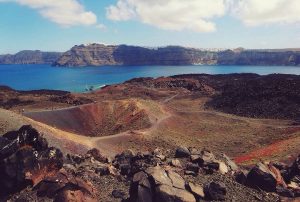The group of islands known as Santorini is unique. Probably the only volcano with a caldera that reaches into the sea, the last major explosion occurred during the Minoan Bronze Age 3,600 years ago. The thunderous fury of nature left its mark on the island, the home of Greece’s last active volcano which still smolders today. The entire center of the circular island sank into the sea during the tremendous volcanic explosion. The eruption caused tidal waves which virtually wiped out the advanced Minoan Civilization of Crete, 70 miles to the south.
The huge mass of pumice thrown out from the Minoan eruption covered the surface of the sea over a wide region and was washed up at higher levels on the shores by the tsunamis triggered by earthquakes. A recent example is the earthquake in Santorini that happened on 9th July 1956, when the tides on the island of Ios reached a height of 25 meters. On most of the shores of the surrounding part of the Aegean, lumps of pumice have been found that clearly drifted on the surface of the water. Pumice was also found on the northern coast of Crete and on the shores of Anafi, Limnos, Paros, Samothraki, Cyprus and even Israel. Experts have discovered traces of this eruption as far as Egypt on the Nile Delta.
What remains today of Santorini is a large crescent shaped island enclosing a west bay and the largest caldera on earth.
